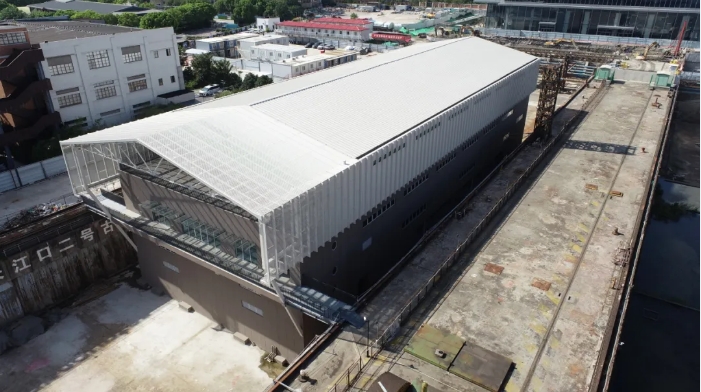
The archaeological work station gets ready for the excavation of China’s largest and best-preserved shipwreck, referred to as the
Yangtze River Estuary No 2
. [Photo/Shanghai Municipal Administration of Culture and Tourism]
Trial excavation operations for China’s largest submerged shipwreck, the Yangtze River Estuary No 2, kicked off at an archaeological work station on Sept 28, set to unravel the mysteries of the country’s maritime past.
Dating back to the Qing Dynasty (1644-1911) under the reign of Emperor Tongzhi, the wooden sailing-vessel was salvaged and carefully relocated to Dock No. 1 at the former site of the Shanghai Shipyard in the Yangpu district in November 2022.
Following the meticulous process of safeguarding the vessel upon its emergence from the depths, a consortium of institutions, including the Shanghai Museum, spearheaded critical tasks such as ship tank support, humidity and microorganism monitoring, emergency heritage protection, and archaeological mapping.
The trial excavation, slated to unfold from September through January 2025, will encompass the excavation of four trial trenches, each spanning 24 square meters and delving three meters deep. The primary objective of this endeavor is to dissect the ancient ship’s complete structure from a vertical perspective, validating methodologies for excavation, cultural relics preservation on-site, hull support, mapping, and laying a groundwork for subsequent phases of the project.
Leveraging cutting-edge technologies and academic research, the archaeological team is poised to unearth a wealth of information pertaining to the vessel, including details about its sailing route, the circumstances of its sinking, and the living conditions experienced by those aboard.
The newly established work station, finalized in August, stands as a testament to the commitment towards protecting underwater cultural relics and ensuring the seamless progression of the excavation process. The facility is equipped with a state-of-the-art multifunctional underwater archaeological laboratory system with three integral modules: an intelligent protection cabin, an integrated archaeological excavation platform, and a heritage protection laboratory. The modules collectively form the nation’s most advanced system in the realm of domestic underwater archaeological laboratories.
Source: official WeChat account of Shanghai Municipal Administration of Culture and Tourism
,https://english.shanghai.gov.cn/en-Latest-WhatsNew/20240930/02e63365d9a645f09ef475ded3ec7718.html
